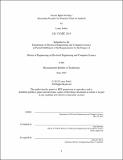Secure Input Overlays : increasing security for sensitive data on Android
Author(s)
Sobel, Louis (Louis A.)
DownloadFull printable version (462.5Kb)
Alternative title
Increasing security for sensitive data on Android
Other Contributors
Massachusetts Institute of Technology. Department of Electrical Engineering and Computer Science.
Advisor
Srini Devadas.
Terms of use
Metadata
Show full item recordAbstract
Mobile devices and the applications that run on them are an important part of people's lives. Often, an untrusted mobile application will need to obtain sensitive inputs, such as credit card information or passwords, from the user. The application needs these sensitive inputs in order to send them to a trusted service provider that enables the application to implement some useful functionality such as authentication or payment. In order for the inputs to be secure, there needs to be a trusted path from the user, through a trusted base on the mobile device, and to the remote service provider. In addition, remote attestation is necessary to convince the service provider that the inputs it receives traveled through the trusted path. There are two orthogonal parts to establishing the trusted path: local attestation and data protection. Local attestation is the user being convinced that they are interacting with the trusted base. Data protection is ensuring that inputs remain isolated from untrusted applications until they reach the trusted service provider. This paper categorizes previous research solutions to these two components of a trusted path. I then introduce a new solution addressing data protection: Secure Input Overlays. They keep input safe from untrusted applications by completely isolating the inputs from the untrusted mobile application. However, the untrusted application is still able to perform a limited set of queries for validation purposes. These queries are logged. When the application wants to send the inputs to a remote service provider, it declaratively describes the request. The trusted base sends the contents and the log of queries. An attestation generated by trusted hardware verifies that the request is coming from an Android device. The remote service provider can use this attestation to verify the request, then check the log of queries against a whitelist to make a trust decision about the supplied data.
Description
Thesis: M. Eng., Massachusetts Institute of Technology, Department of Electrical Engineering and Computer Science, 2015. This electronic version was submitted by the student author. The certified thesis is available in the Institute Archives and Special Collections. Cataloged from student-submitted PDF version of thesis. Includes bibliographical references (pages 44-47).
Date issued
2015Department
Massachusetts Institute of Technology. Department of Electrical Engineering and Computer SciencePublisher
Massachusetts Institute of Technology
Keywords
Electrical Engineering and Computer Science.